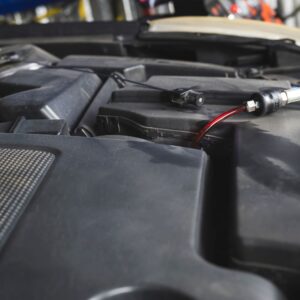Switching from a manual vehicle to an automatic car can prove jarring. Automatic transmissions have parts that don’t exist in their manual counterparts and operate differently. One of the biggest differences is how you should check the vehicle’s transmission fluid. In an automatic transmission, you need to run the engine while measuring the fluid level, which sounds counterintuitive when compared to other automotive fluid checks.
Why Check Automatic Transmission Fluid When the Engine Is Running?
But why do you need the engine running to get accurate readings of the automatic transmission fluid level? It’s because of how an automatic transmission works.
Automatic transmissions have several parts that rely on the engine to drive them. Chief of these is the torque converter, a fluid coupling that connects the engine and transmission.
The torque converter bolts onto the engine’s flexplate, and its upper half sits above the input shaft centerline. It receives transmission fluid from an automatic transmission pump, which is driven by the part of the torque converter that slides into the transmission pump housing and engages the center pump gear.
The automatic transmission pump, since it’s driven by the torque converter, also relies on the engine for driving power. Without a running engine, the pump won’t fill the torque converter.
Since the engine drives both the torque converter and automatic transmission pump, the best time to get an accurate reading of the hydraulic fluid level is when the engine is running.
Tips on Checking the Automatic Transmission Fluid Level
Now that you know why you must check the automatic transmission fluid level when the engine is running, let’s look at some ways to ease and speed up the process.
Park Your Car on a Level Surface
Look for a level surface to park your car for the automatic transmission fluid check. You want to prevent the fluid from tilting toward one side, which can lead to incorrect markings on the transmission fluid dipstick.
Engage the parking brake before checking the transmission fluid level. Additionally, you can wedge wheel chocks under the tires for extra safety.
Warm Up Your Car
Warming up the engine doesn’t necessarily warm up the transmission, so you’ll need to drive it before checking the fluid. The torque converter makes heat as it shears the fluid, and transmission fluid expands as it gets warmer (engine oil does not).
The engine needs to be running when you’re checking the fluid because with the pump working, it has the torque converter filled with fluid and all the other parts of the transmission as well, and it’s pumping fluid through the transmission cooler.
Much of this fluid returns to the transmission oil pan when the engine isn’t running, so you won’t get an accurate reading unless the engine is running and the ATF pump is working.
The engine needs to be running when you’re checking the transmission fluid because with the ATF pump working, it has the torque converter filled with fluid and all the other parts of the transmission as well, and it’s pumping fluid through the transmission cooler.
– Richard McCuistian, ASE Certified Master Automobile Technician
Turn the Engine Off If It’s a Honda
Almost all manufacturers require you to keep the vehicle’s engine running while checking the fluid level in the automatic transmission. The only exception is Honda, which requires you to turn off the engine before you can measure the transmission fluid level.
If you’re checking a Honda-manufactured vehicle, turn off its engine and immediately check its ATF level. Consult with your dealer or a trusted mechanic if you’re unsure.
Find the Transmission Fluid Dipstick
Unlike most manual transmissions, most (not all) automatic transmissions have a transmission fluid dipstick. It works like the oil dipstick in the engine, although it measures the automatic transmission fluid level instead of the engine oil level. Some dipsticks will even have different ranges for cold vs hot fluid.
If you own a front-wheel drive vehicle, you can usually find the transmission fluid dipstick beside the oil dipstick. In rear-wheel drive vehicles, the dipstick is near the engine’s rear. On transmissions without a dipstick, well, that’s a whole different ball game.
The handle of the transmission fluid dipstick is often red to distinguish it from the oil dipstick. Some fluid dipstick handles are pink, while others are yellow.
Using and Interpreting the Transmission Fluid Dipstick
When you pull the transmission fluid dipstick out of its tube, some fluid will cover part of the stick. Wipe the stick with a clean cloth before returning it to the reservoir. Pull it out again.
The dipstick has full and low indicators. If the transmission fluid reaches the full indicator, you can return the dipstick to its tube and continue driving. However, if the fluid is at the low indicator, refill the reservoir as early as possible to avoid problems with the transmission.
Tips When Refilling ATF
Low transmission fluid levels are often responsible for various problems with the transmission. If the fluid level stays low after you refill the reservoir, there might be a leak that needs to be located and repaired.
Add the right amount of transmission fluid to the reservoir. If you add too much, the fluid can foam. The air bubbles that comprise the foam put more pressure on the transmission, leading to excess fluid leaking out of the vent or seals. Foam might lead to issues like gears slipping and instability.
Automatic transmissions are more vulnerable to foam than manual equivalents. Their circuits rely on hydraulic pressure to shift gears. Without sufficient pressure, the transmission might develop issues like clutch slippage.
Checking your automatic car’s transmission fluid level when the engine is running might take time to become a habit, but it’s easier than it initially looks. You’ll be able to do it without a hitch over time.
Where to Get Transmission Fluid for Your Vehicle
You can’t refill the transmission fluid if you don’t have some at your disposal. Visit CarParts.com today to get a fresh batch of high-quality transmission fluid and get your car back on the road.
We have on-hand and ready-to-ship transmission fluid from warehouses near you. These all passed the highest quality control standards, so you’re sure to get a high-quality product.
Shop for transmission fluids at CarParts.com!
Any information provided on this Website is for informational purposes only and is not intended to replace consultation with a professional mechanic. The accuracy and timeliness of the information may change from the time of publication.



































